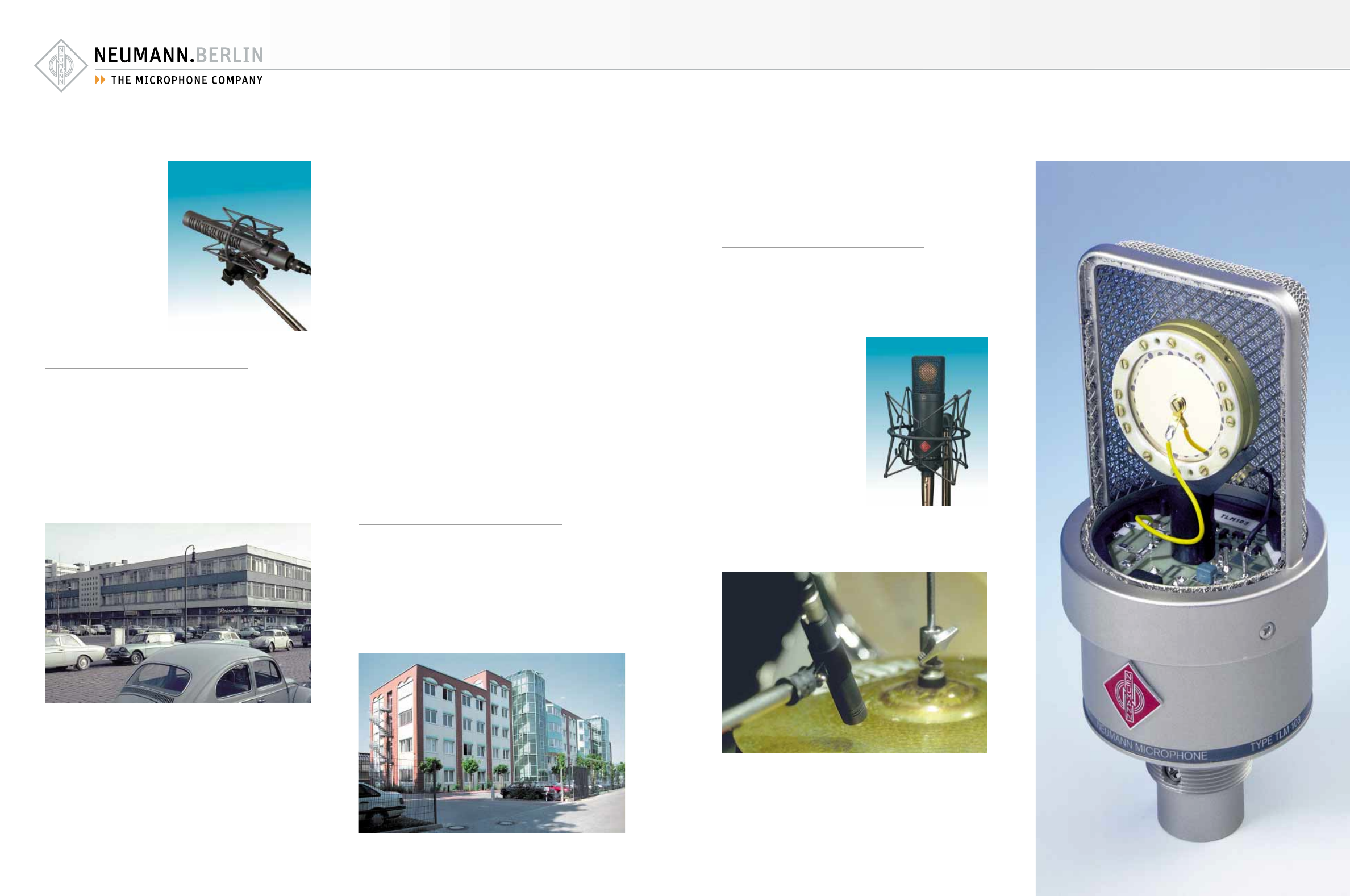
Neumann History
1514
Especially for outdoor re-
cordings the RSM 191
stereo shotgun micro-
phone was developed. The
recording angle of this MS
combination can be ad-
justed for the most di-
verse recording situa-
tions.
Upheaval Everywhere
These dynamic developments in the area of
capsule technology and circuitry coincided not
only with turbulent upheavals in global politics,
but also with changes throughout the Neumann
Company’s corporate structure. For three dec-
ades, the company’s Charlottenstrasse head-
quarters in Berlin near the Allied border check-
point “Checkpoint Charlie” had stood at the
edge of Western Europe. After the fall of the
Berlin Wall in 1989, Neumann suddenly found
itself thrust into the centre of Berlin. The con-
sequence: costs climbed dramatically overnight
and ultimately the company’s building was to
be torn down to make way for a planned sky-
scraper.
The “politics in microcosm” within the compa-
ny, however, was also good for a few surprises.
The Neumann family, which had continued to
hold a controlling interest in the company after
Georg Neumann’s demise in 1976, decided to
sell its shares. TELDEC, which in turn now be-
longed to Warner Brothers, had been an addi-
tional owner since the early seventies. After ne-
gotiation with several prospective buyers, the
Neumann family decided to turn the company
over as a whole to a similarly structured, fami-
ly-run German company that also has experience
in the studio market: Sennheiser electronic
GmbH & Co. KG.
So 1 January 1991 marked the start of a new
chapter in the 62 year history of Georg Neu-
mann GmbH, Berlin. This coincided with two
fundamental changes in the market and thus was
not without consequences: Since the mid eight-
ies, traditional vinyl disk technology had been
increasingly replaced by compact discs. Auto-
mation and digitisation in mixing console tech-
nology demanded ever increasing development
outlay with ever shorter product life cycles for
the components.
Some of the last large consoles in N 7000 tech-
nology were installed in the Berlin Philharmo-
ny and in regional studios of the Austrian
broadcaster ORF.
Since 1993 Neumann concentrates itself on stu-
dio microphones. Herewith lie the core compe-
tence, the tradition, and 70 years experience
of Neumann, Berlin.
Neumann Moves
In 1993, a decision was taken to move micro-
phone production to the parent firm Sennheiser,
located north of Hannover.
Now it was time to break camp and make a
“fresh start” at a new location. This location is
in Ollenhauerstrasse on the Northwest side of
Berlin, not far from Tegel Airport. At Sennheis-
er, in the meantime, a separate “Neumann Pro-
duction Hall” was erected with state-of-the-art
machinery and manufacturing equipment. Thanks
to intense training measures, within a very short
time it was possible to manufacture the entire
line of microphones and accessories at the high
level of quality which the world has come to ex-
pect and appreciate.
New Objectives – New Microphones
Despite all of these very dramatic changes, de-
velopment of new microphones continued at the
usual pace. In 1993, for example, Neumann
launched the TLM 193 large diaphragm micro-
phone. Limitation to those factors that are es-
sential for recording quality, in
conjunction with uncompromis-
ing streamlining of production,
resulted in a new microphone
category. This was a studio mi-
crophone which, by virtue of its
low price, for the first time
reached a demanding new set
of customers who until then
had never even dared dream of
owning a “real Neumann”. This
marked the advent of a new
generation of microphones,
which was continued one year
later with the KM 184. In this
connection, Neumann is espe-
cially proud of the fact that not only do these
microphones have the technical specifications
associated with “real studio microphones”, but
they are also part of the continual, uncompro-
mising improvement of these values. For the
time being, the zenith of this development is
marked by the TLM 103, which was launched in
1997 and received the TEC Award in 1998. For
now, its residual noise of just 7 dB-A makes it
the “quietest” studio microphone on the global
market.















